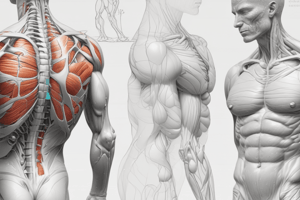Podcast
Questions and Answers
Match the following myotomes with their corresponding functions:
Match the following myotomes with their corresponding functions:
C5 = Elbow flexion C6 = Wrist extension C7 = Elbow extension C8 = Middle finger flexion
Match the dermatome testing points with their corresponding myotome:
Match the dermatome testing points with their corresponding myotome:
C5 = Elbow flexion – biceps brachialis C6 = Wrist extension - extensor carpi radialis longus and brevis C7 = Elbow extension - triceps C8 = Middle finger flexion – flexor digitorum profundus
Match the myotomes with their associated reflexes:
Match the myotomes with their associated reflexes:
C5 = Biceps reflex C6 = Biceps reflex; Supinator reflex C7 = Triceps reflex C8 = No specific reflex mentioned
Match the dermatome levels with their primary locations:
Match the dermatome levels with their primary locations:
Match the dermatomes with their specific muscle actions:
Match the dermatomes with their specific muscle actions:
Match the myotomes with their muscle groups involved:
Match the myotomes with their muscle groups involved:
Flashcards are hidden until you start studying
Study Notes
Dermatome Testing Points
- C5 dermatome: Lateral antecubital fossa (area near the elbow joint)
- C6 dermatome: Dorsal proximal phalanx of the thumb (back of the thumb)
- C7 dermatome: Dorsal proximal phalanx of the middle finger (back of the middle finger)
- C8 dermatome: Dorsal proximal phalanx of the little finger (back of the little finger)
- T1 dermatome: Medial antecubital fossa (area near the elbow joint on the inside of the arm)
Myotome Testing Points
- C5 myotome: Elbow flexion (bending of the elbow), tested by the biceps brachii muscle
- C6 myotome: Wrist extension (straightening the wrist), tested by the extensor carpi radialis longus and brevis muscles
- C7 myotome: Elbow extension (straightening the elbow), tested by the triceps muscle
- C8 myotome: Middle finger flexion (bending the middle finger) at the distal phalanx (tip of the finger), tested by the flexor digitorum profundus muscle
- T1 myotome: Little finger abduction (spreading the little finger away from the other fingers), tested by the abductor digiti minimi and interossei muscles
Reflex Testing
- C5 reflex: Biceps reflex, tested by tapping the biceps tendon just above the elbow
- C6 reflex: Biceps reflex (also tested at this level), supinator reflex (tested by tapping the radial styloid process at the wrist)
- C7 reflex: Triceps reflex, tested by tapping the triceps tendon just above the elbow
Dermatome Testing for C5-T1
- C5: The dermatome for C5 covers the lateral antecubital fossa, which is the area just proximal to the elbow joint.
- C6: The dermatome for C6 covers the dorsal proximal phalanx of the thumb.
- C7: The dermatome for C7 covers the dorsal proximal phalanx of the middle finger.
- C8: The dermatome for C8 covers the dorsal proximal phalanx of the little finger.
- T1: The dermatome for T1 covers the medial antecubital fossa, which is the area just proximal to the elbow joint.
Myotome Testing for C5-T1
- C5: The myotome for C5 is responsible for elbow flexion, which is tested by assessing the strength of the biceps and brachialis muscles. The biceps reflex is also assessed for C5.
- C6: The myotome for C6 is responsible for wrist extension, which is tested by assessing the strength of the extensor carpi radialis longus and brevis muscles. The biceps and supinator reflexes are also assessed for C6.
- C7: The myotome for C7 is responsible for elbow extension, which is tested by assessing the strength of the triceps muscle. The triceps reflex is also assessed for C7.
- C8: The myotome for C8 is responsible for middle finger flexion, which is tested by assessing the strength of the flexor digitorum profundus muscle (distal phalanx).
- T1: The myotome for T1 is responsible for little finger abduction, which is tested by assessing the strength of the abductor digiti minimi and interossei muscles.
Studying That Suits You
Use AI to generate personalized quizzes and flashcards to suit your learning preferences.




